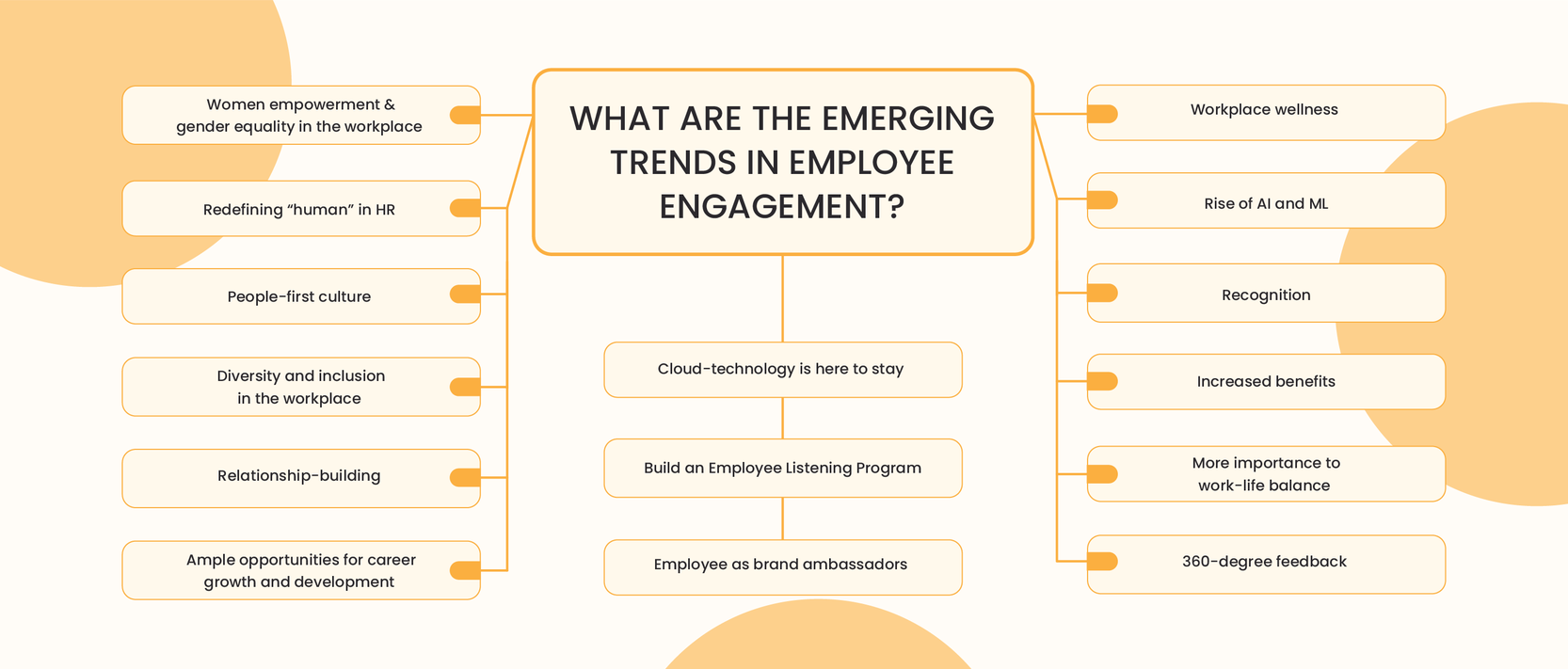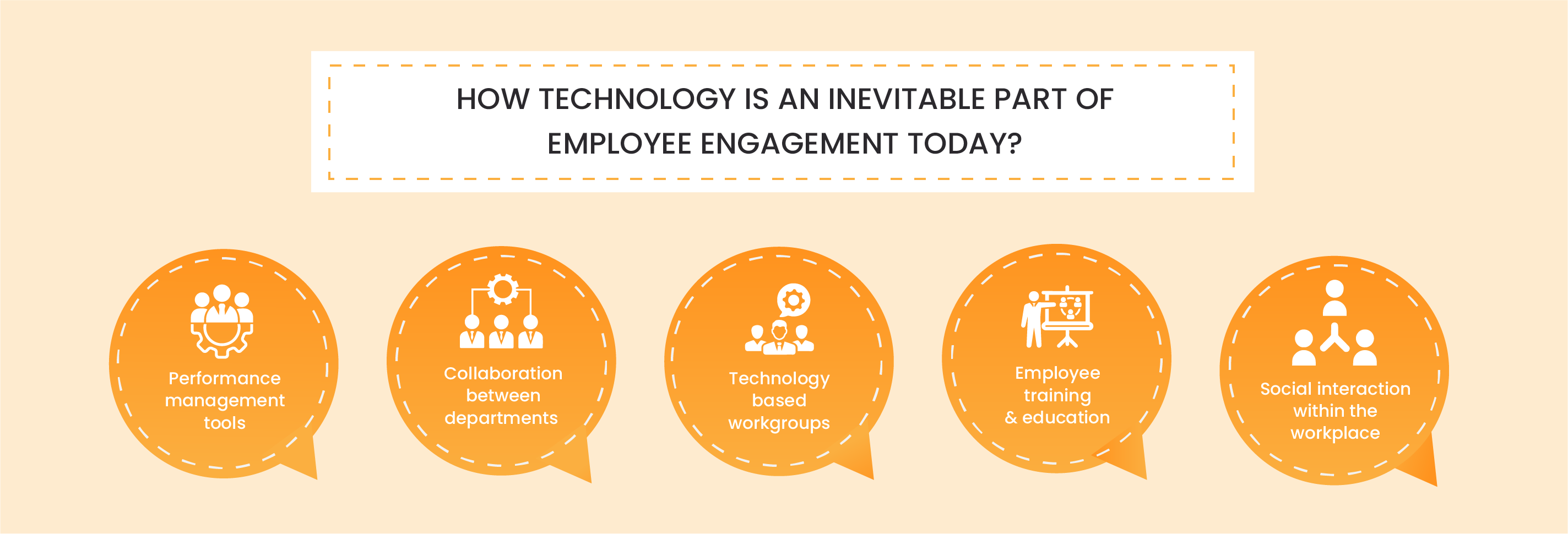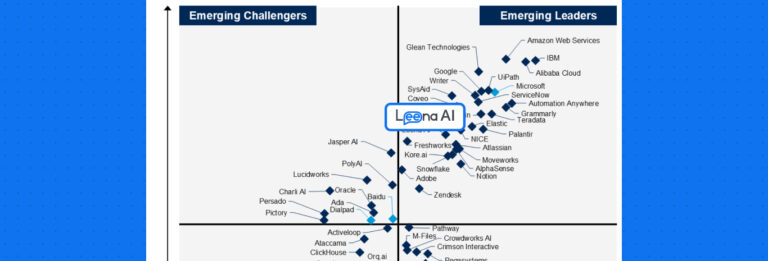Employee engagement isn’t a new organizational strategy, however, every few years new employee engagement trends set the ball rolling. The last few years have seen a focused shift towards employee engagement because of the transformations in the workplace.
Global employee engagement trends have shifted considerably in lieu of the pandemic. Covid-19 gave rise to new trends in employee engagement that was in-line with the realities of the new normal. While the last 2 years were all about remote employee engagement, employee engagement trends 2023 are all about maximizing the employee experience in hybrid workplaces.
The desire to boost employee engagement in hybrid workplaces has been spreading like wildfire among HRs and businesses today. A highly engaged workforce that adds value and revenue to the business is the dream of every organization. To accomplish this, HRs are now constantly experimenting and innovating with their employee engagement strategy.
The pandemic was accompanied by job uncertainty, layoffs, and the great resignation phase. All this increased the need for employee engagement initiatives, for organizations to relook at their employee engagement strategy, and start afresh.
Employee engagement trends continue to evolve even as you read this, however, we’ve compiled the top employee engagement trends 2024 that promise to work in these unprecedented times.
The cost of not upgrading your employee engagement strategy

Many companies worldwide experienced a dip in their employee engagement levels post-pandemic, thanks to mass layoffs, furloughs, closures, job losses, and transition to remote work. In fact, Gallup recorded the historic decrease in engaged employees to 31% — which was 34% earlier.
While there can be many reasons for the drop, here are a few major ones:
- Lack of communication: Since the beginning of the COVID-19 crisis, leaders have communicated and shared more information than ever before. They spoke about safety measures, current and upcoming challenges, and so on. But today, communication has tapered, and so have the transparency and trust among employees in leadership.
- Lack of flexibility: As COVID-19 vaccines are speeding up, many organizations are calling employees back to the office — despite their wish to have a flexible work environment. What organizations need is to build a hybrid workplace where employees feel comfortable. However, when employees feel that flexibility, clear expectations, and manageable workloads are lacking, they become stressed, resulting in low engagement levels.
- Lack of employee health and wellness support: Employee health and wellness initiatives have reduced from 87% in April of 2020 to 82% in Q2 of 2021, which is clearly visible in the employee experience. When they feel the organization doesn’t prioritize their needs and health, their engagement declines.
As the engagement rates have changed drastically in the past months, there’s a need to leverage ways to upgrade employee engagement strategies and experience. However, it’s possible only when you keep yourself up-to-date with the latest employee engagement trends behind this ever-changing modern workplace.
What are the latest trends in employee engagement?

1. People-first culture
There‘s nothing more important to the health of a business than the health of its people. It is one of the most critical employee engagement trends HRs must adopt. Therefore, the present circumstances demand the company to develop a harmonious and employee-oriented culture, also known as people-first culture.
It is a culture where the organizations create a desirable workplace that listens to and values the employees’ needs. When you consider your employees as people first, they become happy and more responsive to customers’ demands. Plus, a feeling of care and respect is fostered among them, decreasing their chances of leaving the organization searching for a better opportunity.
2. Increased benefits
Due to the shift in the workplace environment, employees’ needs have drastically changed. People want organizations to fulfill their basic needs first compared to surface-level office perks like free snacks, company merchandise, or a foosball game table. Instead, they want benefits that make them feel appreciated and motivated at work.
Hence, employees need to level up their game when it comes to benefits for engagement boost. Some benefits you can offer include health insurance, paid time off, family leave, flexible schedule, team lunch, work-life balance, child care, and wellness programs. This employee engagement trend promises positive and visible results.
3. More importance to work-life balance
Due to sudden lockdowns and stay-at-home orders, companies worldwide transitioned to remote working. COVID-19 made organizations realize that most operations do not require employees to be physically present in the office. And, it’s time to leverage flexible shifts and remote working as part of the company culture.
Therefore, the future of employee engagement trends will witness increased flexibility to improve work-life balance. Employees with better work-life balance will be more satisfied with their work and more engaged with their co-workers, customers, and the overall business.
4. Cloud-based technology is here to stay
From employee performance management tools and pulse survey software to employee benefits platform and recognition tools — cloud technology can be integrated into almost every aspect of human resource management.
These tools are a win-win solution for both employers and employees. Not only do they make the HR processes easier, but they also help organizations to deliver better and quicker results. Further, they enable employees to engage remotely with the business, irrespective of their location. Hence, 2023 will see increased use of AI-powered HR technology in improving employee experiences. This employee engagement trend is here to stay!
5. Rise of AI and ML
HR tools are already playing a vital role in managing employees. Now, this employee engagement trend is expected to rise due to the inundation of machine learning (ML) and artificial intelligence (AI) in the workplace.
Many organizations have started using AI and ML in multiple HR functions and received incredible results. AI-enabled chatbots and predictive analytics can boost effective communication and personalized employee experiences in the workplace. Plus, HR professionals can make informed, analytics-driven decisions and understand the drivers of employee engagement and productivity.
To understand better the impact of AI in employee engagement, do read our blog that talks in-detail about the amalgamation of artificial intelligence and employee engagement.
6. Redefining “human” in HR
Technology has become an indispensable part of building an engaged workforce. However, people still seek compassion, appreciation, belongingness, and recognition at the workplace. That’s why elevating “human” in human resources will become relevant in the future.
This means including more humanity in the workplace for employees and understanding what truly drives them. A good company culture combined with compassionate managers will boost employee engagement and provide them with ultimate job satisfaction. Hence, embracing technology is excellent, but remember that you can’t form interpersonal bonds without “human” leaders.
7. Diversity and inclusion in the workplace
Diversity and inclusion are critical for improving business results and boosting employee engagement in an organization. When people from different countries, cultures, ethnicities, and traditions come together, they bring innovative ideas to the table. Further, they offer new perspectives and ways of problem-solving and feel more engaged.
Diversity is when an organization hires a workforce of different ages, gender, race, nationality, and more. Inclusion is the culture where a mix of people work together, with a feeling of belongingness, comfort, and psychological safety. Diversity and inclusion go hand-in-hand — diversity can also happen when a company encourages inclusion for all employees.
So, if you’re not making diversity and inclusion part of your organization, do it NOW.
8. Women empowerment and gender equality in the workplace
In the past few decades, the role and position of women have changed, and they form a considerable part of the workforce. Despite these accomplishments, they still have to face various challenges, such as low wages, sexual harassment, lack of security, pregnancy discrimination, etc. These issues are so prevalent that they create mental problems, limiting their productivity and growth.
However, movements like #Metoo and #TimesUp, have taken the social media world by storm. Women are not only standing up to fight against these injustices but also sharing their stories. Hopefully, 2023 and beyond will see organizations taking more and more steps to eliminate these problems.
9. Employee as brand ambassadors
Employees can play a massive role in building an organization’s brand awareness. Many organizations are leveraging employees’ social channels for sharing their brand messages, thereby turning them into brand ambassadors. Companies who jump on this bandwagon experience increased employee engagement, retention, and long-lasting employee-employer relationships.
However, before you leverage employee branding, here are a few things you should consider:
- Your employees cannot tell a story about your product or service if they’re unaware of it. So, educate them about your company’s value by conducting brand training.
- Ensure your organization is a fun and effective workplace, or else attrition rates will increase.
- Lastly, communicate your branding campaign goals to employees.
10. Ample opportunities for career growth and development
Career development and growth are one of the major drivers of employee engagement. People want to work with organizations that help them grow their skills and offer multiple opportunities to develop their careers. In fact, employees are likely to stay longer at a company that provides various learning solutions to meet the requirements of a diverse, multi-generational workforce.
Therefore, companies should invest in learning, development, and mentoring. Further, e-learning platforms make it easy for employees to choose what, where, and when they learn. They can log in and complete a module anytime, anywhere, and from any device. Such platforms allow employees to take responsibility for their professional development, and you get to review their progress. This employee engagement trend promises positive and visible results.
11. Workplace wellness
Another one of the most important employee engagement trends to adopt. Employees spend a huge amount of time in their workplaces. But, if work becomes a major source of their stress, they’re likely to become disengaged and perform poorly. That’s why leveraging wellness programs should be one of the main employee engagement initiatives in the organization.
Strong health and wellness programs boost not only the productivity level of employees but also the work-life balance. Plus, it is also financially sound for companies as they help increase their bottom line. Some wellness program ideas include mental health training and coaching, team building activities, physical exercise, flexible working hours, gym or yoga class subscriptions, mindfulness app subscriptions, and more.
12. Build an employee listening program
In this ever-evolving work environment, it’s more important than ever to effectively listen, support, and engage with your workforce throughout their journey. It is one of the most critical employee engagement trends HRs must adopt.
Building an employee listening strategy helps companies understand what’s happening among their employees, who are their top performers, and ensure their programs support their workforce. This is an excellent way to improve employee experience and ultimately boost employee engagement.
To implement an employee listening strategy, pulse surveys can be your best bet. These allow HR professionals to understand employee perceptions about your company or programs. Plus, they can also help address their concerns during times of change, transition, or disruption.
13. 360-degree feedback
Organizations can’t expect to drive engagement without a proper feedback system. This means providing feedback to your team and taking feedback from them.
Companies are more likely to thrive in 2023 if they leverage 360-degree feedback, which is a method that provides employees the opportunity to receive confidential, anonymous feedback from their managers, peers, coworkers, and customers.
The goal here is to help each worker understand their strengths and weaknesses in different aspects of their work so they can work on improving their performance. Further, organizations can act on the feedback by pivoting business models and discovering new business opportunities. This employee engagement trend is crucial for HRs to adopt and understand the existing state of mind of their employees.
14. Relationship-building
Any successful business thrives on strong, long-lasting relationships. However, traditional ways of building networks, such as offline events, conferences, meetups, and more, don’t work — at least until things get back to normal. Further, employees have found it difficult to maintain emotional connections at work, thanks to social distancing and remote working.
Therefore, 2023 should prioritize building emotional connections and relationships at work, whether they work in-office or from home. Organizations must look for ways to eliminate loneliness and understand communication preferences across the teams. By doing so, they can build positive work cultures, boost employee engagement and loyalty, and increase profits.
15. Recognition
Receiving praise and recognition from leaders is a critical employee engagement trend that has never failed. Before the pandemic, it was easy to praise coworkers and employees during meetings and other informal interactions. But now, employee recognition has become limited as many workers work remotely, and simple recognition efforts aren’t readily available. As a result, they feel left out, impacting their engagement levels.
The need is to embrace technology-driven employee recognition ideas to boost employee performance. This way, you not only motivate individuals but help increase productivity and output from your entire team. This employee engagement trend promises positive and visible results.
16. Introduce goal tracking
Never underestimate the importance of setting goals for employees. Setting goals effectively boosts employee engagement by developing a sense of pride in each individual’s achievements. To be successful on their own, employees must have a clear understanding of their job and the manager’s and employer’s expectations for particular responsibilities. According to Gallup data, approximately half of all employees are confused about their responsibilities, which negatively impacts their ability to engage.
Even the most autonomous team members benefit from setting goals since it puts them on the same page as their coworkers and provides a focal point for their efforts.
But goal-setting includes much more than simply organizing everyday tasks. Goals and performance are intertwined, making them an indispensable link for continuous workplace feedback. Consequently, if you’re looking for a means to reduce your dependency on out-of-date annual performance evaluations, you should begin by examining how you set staff objectives.
17. People analytics tools
Tools for people analytics enable the collection and analysis of HR data easier and more efficient. They enable the exploration of links and causality and the ability to make data-driven decisions regarding how to advance or improve. Examples of people analytics data include workforce composition, cost per hire, employee engagement, staff turnover rate, gender pay equity, and diversity.
HR best practices, business interactions, and the HR-employee relationship can all be transformed with the assistance of high-quality insights acquired and displayed through people analytics solutions.
18. Allow Remote work
However, remote employment poses issues for employee engagement. Effective communication is required more than ever to guarantee that all employees are aware of organizational standards and respond correctly.
Ensure that your employees have reasonable expectations for their remote work. Exactly how many hours every day do you anticipate your employees to work? Companies must adapt, respond, and accelerate in order to satisfy the needs of their employees, whether they are located in the next office or halfway around the world.
19. Skill Training and development of personnel
Strategic people planning enables organizations to engage the essential professionals for a balanced implementation of corporate strategy. Planning your personnel is essential to the success of your business. Consequently, investing in staff training will be one of the most significant employee engagement trends in 2023. Effective training fosters the growth of key skills and abilities necessary for the progress of the organization by providing employees with essential educational material.
HR professionals should utilize HR analytics solutions for strategic planning and assessing the engagement of a merged workforce. Increasingly, contemporary organizations are attracting both full-time employees and independent contractors. In the next years, it is anticipated that their percentage of the company’s workforce will exceed 30 percent.
20. Effective employee adaptation planning
According to various studies, up to 20% of layoffs occur within the first 45 days of employment. This illustrates the need for new recruit adaptation. When hiring a new employee, engagement should not be your main concern. It should be given top priority from the start.
An HR professional’s daily responsibility is to swiftly and accurately recognize a reduction in employee motivation and engagement. He/she must be capable of identifying and operating alarms. Signs of professional burnout include decreased job performance, persistent negativity, apathy, etc.
Why technology is an inevitable part of the new trends in employee engagement?

As big organizations use AI-based solutions for employee engagement, the popularity of artificial intelligence and chatbots is growing, and more HR professionals have become interested in leveraging this technology for automated increased interactions and a smoother employee experience.
Here are five new trends in employee engagement to incorporate into your business:
1. Performance management tools
Performance management helps organizations establish a motivating work culture and stay ahead of the competition. However, a Gartner report shows that 95% of HRs are unhappy with their current performance management practices. That’s where using performance management tools can help keep your employees motivated and engaged.
Performance management tools include important HR functions, like goal-setting, feedback, rewards, and performance appraisal. This helps HR managers establish clear performance expectations so employees can understand what to expect out of their job.
In a nutshell, tools, like Leena.ai, seamlessly measure, report, and manage the company’s progress to improve its performance — both at an individual and corporate level.
2. Collaboration between departments
On average, how many emails do you send to your team every day? And how much time does it take you to brief your co-worker on projects? If your answers make you cringe, consider using collaboration tools.
Collaboration is one of the crucial elements of a successful business. This type of communication between departments can help employees stay connected and remain engaged. Collaboration tools offer tons of options — from project and communication management to instant messaging and video conferencing.
In short, collaboration software can:
- Connect team members across time zones and languages
- Secure file sharing within departments
- Serve as a central point of communication
- Enable real-time feedback
3. Technology-based workgroups
An employee workgroup is basically a virtual community of team members created for work discussion and collaboration. These enable your employees to engage, sync, and share information throughout the project, such as budgets, deadlines, documents, and so on.
Numerous HR platforms provide business cloud services that allow you to create workgroups to store and share information and collaborate with your team. Plus, it enables employees to communicate with co-workers within different departments. Not only that, you can view the progress of tasks completed by your employees and provide them with feedback.
4. Employee training & education
In the constantly changing work environment, employee training and development are vital for businesses to stay ahead of the competition. And nothing can get this done as efficiently as an employee training software can.
An employee training and development tool help measure the engagement levels of your employees, review course completion rates, and satisfy all your company training needs. Plus, it offers employees a flexible schedule to attend sessions at their own pace. What’s more, organizations can create customized content for different workers and deliver a personalized training experience to them.
5. Social interaction within the workplace
Social interaction using technology can foster long-lasting relationships between you and your employees.
Socially engaging with your employees is excellent for creating brand awareness. They can actively promote your business by sharing their opinions, thoughts, and feedback about the organization or upcoming projects or promotions. Plus, they can help you attract and reach out to potential clients and find out the latest information about competitive business products or services.
In a nutshell, employee experience is also now a critical part of organizations’ digital transformation plans. Businesses now look at their employees as customers who would love to share their experience with the company into the marketplace. Therefore, a smooth and efficient employee experience is mandatory. To know more about employee experience softwares and how to choose one, click here to read an in-depth blog.
Summing up
Due to such challenging times, the ways to keep employees engaged have also evolved. Therefore, scaling your employee engagement activities is vital to any business, irrespective of its size or financial standing.
Organizations that can stay on top with the latest employee engagement trends and keep consistent throughout the employee’s life cycle will successfully keep their people happy. And to achieve this, investing in the right technology and tools can go a long way.
If you’re looking for an HR tool to drive employee engagement in your company, Leena AI can help.
Explore Leena AI's employee engagement solutions
Schedule a demo todayFrequently Asked Questions
How many questions should an employee engagement pulse survey have?
The ideal employee engagement pulse survey includes 10-15 well-crafted questions, carefully designed to capture key insights on employee satisfaction and motivation. These questions should revolve around at least two essential themes, such as work environment, communication, recognition, and growth opportunities. The survey’s concise format, taking just 5-10 minutes for participants to complete, encourages higher response rates and minimizes respondent fatigue. By efficiently gauging employee sentiments, organizations can gather valuable feedback, identify areas for improvement, and foster a more engaged and productive workforce.
What are the key drivers of employee engagement?
To effectively assess employee engagement, crafting survey questions based on key drivers is crucial. These drivers, including job satisfaction, relationships with colleagues, leadership effectiveness, work-life balance, team dynamics, management support, and communication, significantly impact engagement within an organization. By tailoring survey inquiries around these drivers, employers can gain comprehensive insights into employee engagement levels. Understanding these crucial aspects enables organizations to address specific concerns, implement targeted improvements, and ultimately foster a more motivated and contented workforce.
Does employee engagement really drive productivity?
Employee engagement plays a vital role in driving productivity within a company. This substantial boost in productivity stems from engaged employees’ enthusiasm, dedication, and commitment to their work. Moreover, a well-crafted employee engagement strategy not only enhances productivity but also contributes to improved customer retention. Engaged employees are more likely to deliver exceptional customer service, leading to higher customer satisfaction and loyalty. Additionally, a positive work environment that fosters engagement also aids in retaining talented employees. When employees feel valued and connected to their organization, they are more inclined to stay, reducing turnover and its associated costs. Overall, prioritizing employee engagement yields far-reaching benefits, from enhanced productivity to heightened customer loyalty and employee retention.
What are some ideas to improve employee engagement?
To bolster employee engagement, organizations can embrace various effective strategies. Emphasizing diversity, equity, and inclusion (DE&I) initiatives fosters a more inclusive and welcoming workplace, making employees feel valued and respected. Offering enhanced benefits, such as flexible work arrangements, wellness programs, and career development opportunities, demonstrates a commitment to employees’ well-being and growth, further boosting engagement. Embracing cutting-edge technologies can also have a significant impact. Adopting cloud-based collaboration tools enables seamless communication and teamwork, while AI-powered employee engagement tools can provide personalized experiences, recognition, and learning opportunities tailored to individual preferences.







2 Comments